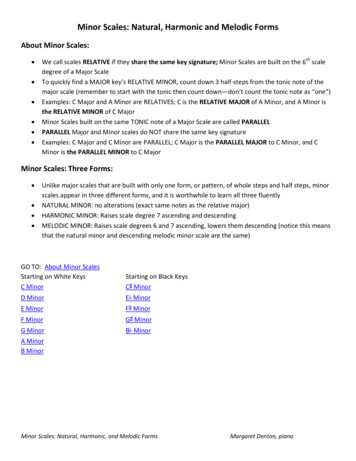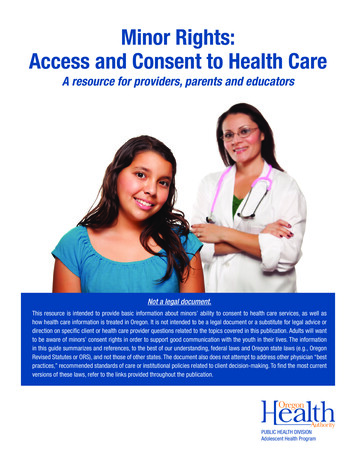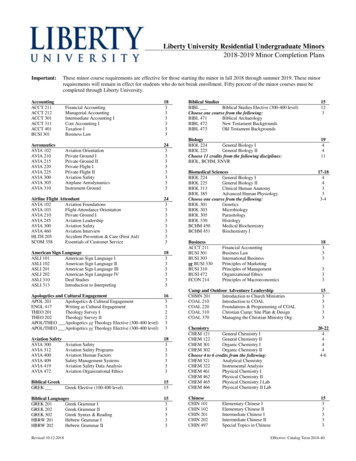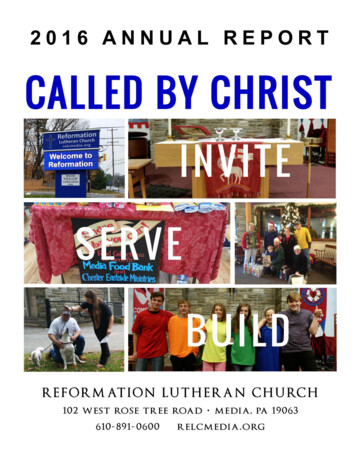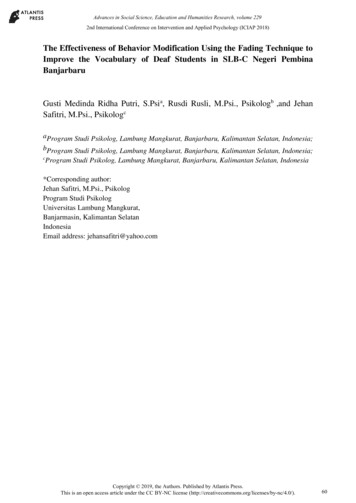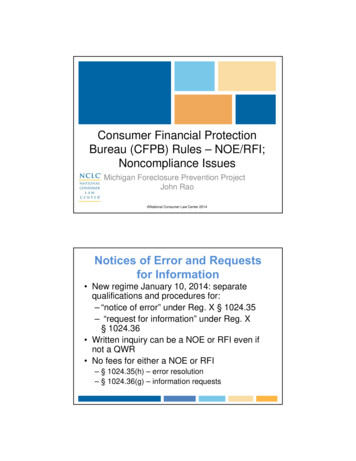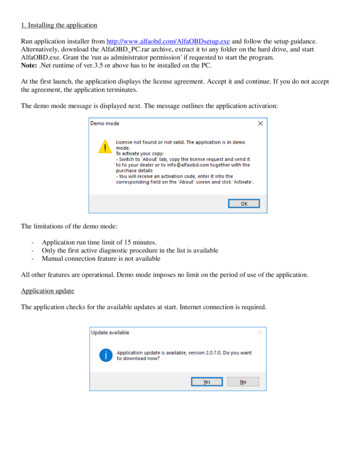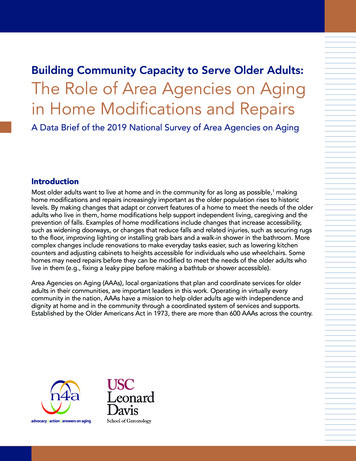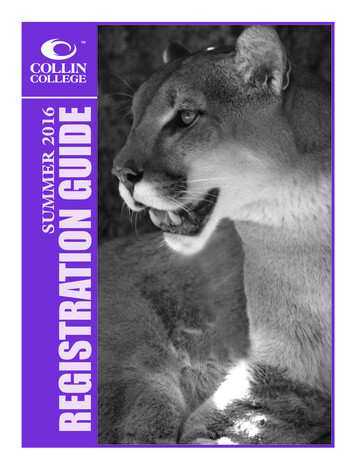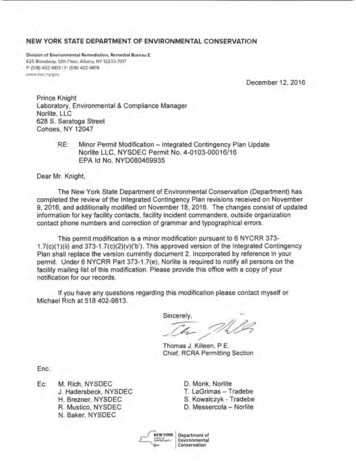
Transcription
NEW YORK STATE DEPARTMENT OF ENVIRONMENTAL CONSERVATIO NDrvision of Environmental Re me d iation, Re me dia l Bure a u E625 Broadway, 12th Floor, Alb 1ny, NY 12233-7017P: (518) 402-9813 I F (SIB) 402 -9819www.ctec.ny govDecember 12, 2016Prince KnightLaboratory, Environmental & Compliance ManagerNorlite, LLC628 S. Saratoga StreetCohoes , NY 12047RE:Minor Permit Modification - Integrated Contingency Plan UpdateNorlite LLC , NYSDEC Permit No. 4-0103-00016/16EPA Id No. NYD080469935Dear Mr. Knight,The New York State Department of Environmental Conservation (Department) hascompleted the review of the Integrated Contingency Plan revisions received on November9, 20 16, and additionally modified on November 18, 2016. The changes consist of updatedinformation for key facility contacts , facility incident commanders , outside organizationcontact phone numbers and correction of grammar and typographica l errors.This permit modification is a minor modification pursuant to 6 NYC RR 3731.7(c)(1 )(ii) and 373-1 .7(c)(2)(v)('b'). This approved version of the Integrated ContingencyPlan shall replace the version currently document 2. Incorporated by reference in yourpermit. Under 6 NYCRR Part 373-1 .7(e) , Norlite is required to notify all persons on thefacility mailing list of this modification. Please provide this office with a copy of yournotification for our records .If you have any questions regard ing this modification please contact myself orMichael Rich at 518 402-9813.Sincerely,- /r? Thomas J . Killeen, P.E.Chief, RCRA Perm itting SectionEnc.Ee:M. Rich , NYSDECJ. Hadersbeck, NYSDECH. Brezner, NYSDECR. Mustico, NYSDECN. Baker, NYSDECD. Monk, NorliteT . LaGrimas - TradebeS. Kowalczyk - TradebeD. Messercola- NorliteWVORI Hrr':LHrnDepartment ofEnvironmentalConservation
INTEGRATED CONTINGENCY PLANNORLITE LLCCOHOES, NEW YORKNYD080469935PREPARED BY:NORLITE LLC628 SOUTH SARATOGA STREETCOHOES, NEW YORK 12047November2016
INTEGRATED CONTINGENCY PLANTABLE OF CONTENTSSECTION IPLAN INTRODUCTION ELEMENTS1.11.21.3SECTION IIPurpose and Scope of Plan CoverageCurrent Revision DateGeneral Facility Identification InformationCORE PLAN ELEMENTS2.12.22.3II.4DiscoveryInitial ResponseSustained ActionsTermination and Follow-Up ActionsSECTION IIIANNEXESAnnex 1.Facility and Locality InformationAnnex 2.NotificationAnnex 3.Response Management SystemAnnex 4.Incident DocumentationAnnex 5.Training and Exercise DrillsAnnex 6.Response Critique and Plan Review and Modification ProcessAnnex 7.PreventionAnnex 8.Regulatory Compliance and Cross Reference MaterialsIntegrated Contingency Plan – October 20162Norlite LLC
INTEGRATED CONTINGENCY PLANThis Integrated Contingency Plan (ICP or Plan) for the Norlite, LLC facility is organizedinto three main sections: 1) Plan Introduction Elements; 2) Core Plan Elements; and 3) Annexes.The elements contained in these sections are accepted emergency response activities that arecurrently addressed in various forms in existing contingency planning regulations. The goal is toprovide a mechanism to consolidate existing concepts into a single functional plan structure.This approach should provide a consistent basis for addressing emergency response concerns.This Integrated Contingency Plan is incorporated by reference into the Part 373 Permit for theNorlite LLC facility. In the event that changes are made to the facility that affects the content ofthis plan, this plan will be updated in accordance with the requirements of Condition D ofModule 1.Section 1 - Plan Introduction ElementsThe introduction section of this ICP is designed to provide facility response personnel,outside responders, and regulatory officials with basic information about the Plan and the entity itcovers. It includes a statement of purpose and scope, information on the current revision date ofthe plan, general facility information, and the key contact(s) for plan development andmaintenance.1.1 Purpose and Scope of Plan CoverageThis Integrated Contingency Plan (ICP) has been prepared by Norlite located at 628South Saratoga Street, Cohoes NY to fulfill the spill prevention and emergency responserequirements of the various federal and state regulations to which Norlite, LLC is subject. Across-reference matrix is provided for each of the applicable requirements. Specifically, the ICPis designed to comply with the following requirements:Integrated Contingency Plan – October 20163Norlite LLC
RequirementAcronymContingency Plan andEmergency ProceduresEmergency Action PlanSpill Prevention, Controland CountermeasurePlanContingencyPlan (alsoHWCP)EAPSPCCAgencyCitationNew York State Department ofEnvironmental Conservation6 NYCRR Part 373-2.4Occupational Safety and HealthAdministrationUnited States EnvironmentalProtection Agency29 CFR 1910.38(a), 1910.119,1910.12040 CFR Part 1121.2. Current Revision DateThis ICP is maintained on-site and is available for review at all times. The following tableprovides a brief summary of the revisions made to this ICP.RevisionNumberRevision DateRevision Description12June 16, 2014October 17, 2016Creation of the Integrated Contingency PlanUpdates to the Emergency Coordinators/Responders1.3. General Facility Identification Informationa.Facility nameb.Owner/operator/agentNorlite, LLCTradebe Environmental Services, LLC/Norlite LLCc.Physical address of thefacility628 South Saratoga Street, Cohoes NY 12047. AlbanyCounty. Located at 42.755332,-73.702791.Directions from Albany: Take Interstate 787approximately 6.8 miles, Turn left onto Tibbits Ave,Take the 1st right onto NY-32 N. Norlite is locatedapproximately 0.5 miles on the left across from a Speedwaygas Station.d.Mailing address of thefacilityDarrell Monk628 South Saratoga Street, Cohoes, NY 12047Integrated Contingency Plan – October 20164Norlite LLC
e.Other identifyinginformationEPA ID: NYD080469935NAICS: 327992SIC: 3299TRI ID: 12047NRLTC628SOf.Key contact(s) for plandevelopment andmaintenanceg.h.Phone number(s) for keycontact(s)Facility phone numberi.Facility fax numberPrince Knight - Laboratory, Environmental and Compliance ManagerDarrell Monk - Plant d information pertaining to the facility is provided in Annex 1 - Facility andLocality Information including: Description of facility operations:- Norlite is a lightweight aggregate facility which utilizes liquid hazardous and nonhazardous waste as a fuel source in two lightweight rotary kilns. Facility maps: Drawing 373-Map Revised. Facility drawings; refer to the following drawing which provide P&ID information of thefuel farm and kiln area, including emergency shut-off valve information.- NY003-1311- NY003-1312- NY003-1314- NY003-1315- NY003-1317- NY003-1903Integrated Contingency Plan – October 20165Norlite LLC
Facility description/layout, including identification of facility hazards and vulnerableresources and populations on and off the facility which may be impacted by an incident.The layout of the facility, including the entrances and roads inside the facility, evacuationroutes, emergency shut-off valves, response equipment, facility topography, nearbyenvironmentally and economically sensitive areas (e.g. schools, nursing homes, hospitals,commercial district) and muster station is included in Facility Drawing 373-Map Revised,as well as the facility drawingsIntegrated Contingency Plan – October 20166Norlite LLC
Section 2 - Core Plan ElementsThe Core Plan contains essential response guidance and procedures. Annexes containmore detailed supporting information on specific response functions. The core plan containsfrequent references to the response critical annexes to direct response personnel to parts of the ICPthat contain more detailed information on the appropriate course of action for responders to takeduring various stages of a response.2.1. DiscoveryThe discovery actions include those initial actions taken by personnel to recognize anincident, perform a basic assessment to mitigate circumstances if appropriate, and immediatelynotify the proper personnel to respond to the incident including necessary state or local agencies.All facility personnel are trained to recognize an incident based upon the categories defined inAnnex 2 - Notification.Once an incident is recognized, employees will perform a basic assessment as describedin Annex 2 - Notification to determine subsequent actions including but not limited to internalnotifications, information gathering, evacuations and equipment shutdowns. The specific actionsare detailed in the following sections of the Annex 2 (need section).Spill prevention inspections are detailed in Annex 7 - Prevention. In the event of arelease of hazardous materials or wastes resulting from a spill or leak from a container or tank,the procedures outlined in Annex 3 – Response Management System will be followed. Ingeneral, the following steps will be taken: Control the release. Stop the flow of material if it can be performed safely; Remove potential ignition sources and materials in the areas that could be affected by thereleases; Contain the release;Integrated Contingency Plan – October 20167Norlite LLC
Clean up the release and all associated residues; Prevent incompatible waste from being treated, stored or located in the affected areasuntil cleanup procedures are complete; Properly dispose or treat all collected released material; and Ensure that all emergency equipment listed in this ICP is cleaned and fit for its intendeduse before operations are resumed.Specifically, if a leaking container is discovered, the emergency response procedures willbe followed and may include placing the leaking container in an overpack container. Contaminatedsoil, if any, will be removed and placed in a properly-labeled container. In the case of a leakingtank, the material will be contained in its containment dike. The standard emergency responseprocedures will be followed. If possible, the material will be recovered for reuse once the leak hasbeen repaired. Absorbent materials will be utilized to soak up residual materials and then placedinto properly-labeled drums or containers. The diked area may be cleaned with water, whichwill then be transported off-site for proper disposal or processed through the facility’s wastewatertreatment plant.In addition, other inspections are conducted by personnel in order to detect anydischarges that may have taken place. These include: Kiln Field Operator’s Shift LLGF Inspection Report: conducted every 4 hours during thenight shift. The Fuel Farm area is inspected for leaks as well as tank levels are recordedto verify no changes to tank levels have occurred. Fuel Farm Operator’s Daily LLGF Inspection Report: conducted daily by personnel at theFuel Farm. Burner Operator’s Shift Log: Conducted by the kiln burner operators through the shift.The LLGF portion of the rotary kiln is inspected with results of the inspection beingrecorded on the shift log.The facility also utilizes automated discharge detection systems in conjunction with theabove-listed inspections conducted by facility personnel. These systems include:Integrated Contingency Plan – October 20168Norlite LLC
Lower Explosive Limit (LEL) Sensors Oxygen SensorsThe LEL and O2 sensors are located wherever hazardous wastes are stored or transported viapiping. LEL and O2 sensors are found in the LLGF tank storage building, the solids processing(drum) building, the tunnel, and the EQ building located between the two kilns.2.2 Initial ResponseThis Section provides the initial response actions at the Norlite facility.2.2.1Initial NotificationsAt all times, there will be at least one employee either on the facility premises or on call(i.e. available to respond to an emergency by reaching the facility within 15 minutes of a call)with overall responsibility for incident command and emergency response measures.All Kiln Supervisors are trained as Incident Commanders and therefore the on-site kilnSupervisor at the time must have the initial notification. The on-site Kiln Supervisors can bereached on a shared cell phone at 518-587-5737.The on-site Kiln Supervisor must contact one of the following facility IncidentCommanders:Primary Incident Commander:Plant Manager: Darrell MonkOffice: 235-0401 Plant Ext.: 4044Cell Phone: 518-852-3876Alternate:Health & Safety Manager: Danny MessercolaOffice: 235-0401 Plant Ext.: 4005Cell Phone: 518-857-7385Integrated Contingency Plan – October 20169Norlite LLC
Alternate:Environmental Manager: Prince KnightOffice: 235-0401 Plant Ext.:4049Cell Phone: 518-857-2969Alternate:Fuel Farm Manger: David GloverOffice: 235-0401 Plant Ext.:4028Cell Phone: 518-857-4606Contact to outside organizations will either by conducted by the Incident Commander or adesignated person other than the Incident Commander. The following outside organizations maybe contacted: City of Cohoes Fire Department: 518-237-1472 Local Emergency Planning Committee: 911 or 765-2351 West Central Environmental (518) 272-6891 (For spill control and assistance.) NYS 24 Hour Oil and Hazardous Materials Spill Hotline: (518) 457-7362 Albany County Health Department: (518) 445-7835 National Response Center (24 hours): (800) 424-8802 or (202) 426-2675 US Coast Guard: 472-6110 or (212) 264-4860 (Immediate notification as soon asthere is knowledge of an oil release that violates water quality standard or causes asheen on navigable waters.) D&H Railroad Operations Control Center: 271-4414 (If situation involves orinterferes with railroad activity.)2.2.2 US EPA Region II: (201) 548-8730 St. Mary’s Hospital: (518) 268-5000 Mine Safety Health Administration: 489-0573Response Management SystemResponse to any emergency situation will follow the structure of Incident Command-Hazardous Sector Operations, under the regulations of 30CFR Subpart '1910.120.Integrated Contingency Plan – October 201610Norlite LLC
2.2.2.1 Preliminary Assessment and Initial Response Procedures.The procedures for preliminary assessment of the situation, including an identification ofincident type, hazards involved, magnitude of the problem, and resources threatened. Thecriteria for implementation of the ICP for any potential emergency include: threat to human health or the environment; fires/explosions; or unplanned sudden or non-sudden release of hazardous waste or hazardous wasteconstituents to air, soil or surface water.The following procedures will be followed for preliminary assessment of the situation:Step 1:Site Management The ultimate goal of site management is to protect employees and secure thearea of the incident Manage the physical layout of the incident. Approach releases from an uphill, upwind side. Ensure area is isolated and deny entry via barriers, tape, employee guarding. Monitor for breached containers, vapor clouds, unusual odors, or releasedspills. Step 2:Determine if possible, if anyone is injured.Identification of hazardous Materials Determine if possible, without entering area or contacting material, whatmaterials are involved and approximate amount. If entry into area is required to identify material, than this will only be doneunder the direction of the full incident command and emergency response team.No further action can be done at this time except to maintain site control andcontact the Emergency Response Team.Integrated Contingency Plan – October 201611Norlite LLC
If a determination can be made as to the material and amount, or if thematerial is known, the Emergency Coordinator can make the determinationfor response actions or to contact the Incident Commander. For small spills (less than 55 gallons) with known materials, emergencyresponse will be handled under the direction of the Emergency Coordinator. Forlarge spills, or unknown materials, emergency response will be under thedirection of the Incident Commander. Identification of unknown materials will be done with level A protection,under the buddy system, with back up response personnel in place. If at thistime, and identification can be made, than appropriate procedures will befollowed. If identification cannot be made, than outside resources will becontacted to handle the response.Step 3:Hazard and Risk Assessment After specific identification of a material, hazards and risks must bedetermined.Labels, c o n t a i n e r s , s h i p pi n g p a p e r s , M a n i f e s t s , S D S ,o r HAZMATresponseguides s h a l l b e u t i l i z e d . This i sn e c e s s a r y f o r determining potential risk from additional spills, fires orexplosions, and a safety assessment for responders, employees, community andenvironment, determining PPE and response equipment. Assess possible hazards, both direct and indirect, to human health andenvironment and determine control methods. These include: fire wind & direction explosion other hazardous materials toxicity ignition sourcesDetermine if incident can be handled by company's capabilities or if externalresources are necessary. Assess the need for implementing the evacuation plan.Integrated Contingency Plan – October 201612Norlite LLC
Potential for off-site involvement Actual or potential threat to human health and/or extent of injuries sustained Establish "hot", "warm", and "cold" zones. Notify appropriate emergency service groups if there is threat of public healthor the environment.Step 4:Select PPE and Equipment PPE and equipment selection will be based on the material and hazards. If notalready determined, this will be done by Equipment Officer.Step 5:Information and Resource Coordination A command post shall be established, close enough to view the site, farenough to prevent contamination and be upwind. The command post shall be well marked. Representatives from other agencies should be available if needed at thecommand post. Identification of key officers is established at this time if not already done so,via vests or other identification measures. Checklists shall be handed out at this time (if not already done so) for eachofficer and their roles.Step 6:Control and Containment Remove all hazards present, including flammable materials, if safe to do so. Spill control will be initiated before leak control measures are implemented. Controlling vapors and gasses is limited to shutting off the supply if safe to doso. Additional outside resources will be contacted for assistance. Liquids are controlled by diverting, diking, or retaining and absorption orcontain or direct to sumps. Leak control measures will be taken after spill control has been completed.This is controlling the leak at the source or container.This can beaccomplished by:Integrated Contingency Plan – October 201613Norlite LLC
Step 7: Emptying or transferring material Diverting flow Patching or pluggingDecontamination This process makes people, equipment and supplies safe by eliminatingharmful substances.This is done under the direction of the EquipmentOfficer. Processes utilized will be dilution, absorption, or neutralization, or acombination of. Allaffected responsepersonnel, equipment andfacilities willbedecontaminated prior to entering the "cold zone". Arrange for proper disposal of all contaminated materials, including insuringthat incompatible wastes are not mixed with released materials.2.3. Sustained ActionsSustained actions which transition beyond the initial emergency stage will be handled bythe Incident Commander in charge of incident.Sustained actions will most likely requireassistance from outside sources such as the fire department, LEPC, or contracted response services.An example of a sustained action would be a release to a stream or significant fire.2.4. Termination and Follow-Up ActionsFinal Step:Termination Ensure situation is under control. All utilized safety equipment must be inspected to be sure it is cleaned and in a readystate. Investigation and documentation of the incident. Ensure health monitoring of response personnel if appropriate. Notification to proper authorities that activities have been completed. Determine when an "all-clear" can be given to resume normal activities. File report within 15 days of the emergency action.Integrated Contingency Plan – October 201614Norlite LLC
Once any emergency is declared over, the following procedures describe how the orderlydemobilization of response resources will occur. As part of the Contingency Plan activation notification letter due 15 days after anincident, the facility will conduct a root cause analysis to determine the cause of theincident. The final notification letter will be submitted to the Region 4 RegionalRemediation Engineer. From the results of the root cause analysis, the company will institute corrective actionmeasures which will help ensure a similar situation does not occur again.During the root cause analysis, the company will evaluate the response procedures followedduring the incident and implement new procedures if deemed necessary to ensurepublic health and environmental protection.In the event of an incident at the facility, the following information will be documented andsubmitted for review upon request:a) incident history (time, date, location, etc.);b) notifications made;c) emergency response personnel involved (name of organizations and times on-site)d) agency personnel on-site (names of agencies and times on-site)e) description of response actions;f) cause(s) of the incident;g) types of chemical(s) released and impacted media (e.g. soil, air, water);h) quantity of chemicals released;i) resources impacted (i.e. community, natural resources, etc.);j) personnel/responder injuries; andk) corrective actions and enforcement.Integrated Contingency Plan – October 201615Norlite LLC
ANNEXESIntegrated Contingency Plan – October 201616Norlite LLC
ANNEX 1FACILITY AND LOCALITYINFORMATIONIntegrated Contingency Plan – October 201617Norlite LLC
Annex 1: Facility and Locality InformationA1.1 Facility Location and LayoutThe layout of the facility, including the entrances and roads inside the facility, evacuationroutes, emergency shut-offvalves, responseequipment, facility topography, nearbyenvironmentally and economically sensitive areas (e.g. schools, nursing homes, hospitals,commercial district) and muster station are included in the following figures:a.Facility Map: Drawing 373-Map revised. This drawing identifies each building on thefacility, have topography information, wind row information, location of the nearestneighbors, environmental receptors, and facility entrances which are to be used as rallypoints dependent upon wind direction.b.Facility Drawings: refer to the following drawings which provide P&ID information ofthe fuel farm and kiln area, including emergency shut-off valve information. NY003-1311 NY003-1312 NY003-1314 NY003-1315 NY003-1317. The layout will be made available to the police, fire departments, State/local emergencyresponse teams, response contractors and equipment suppliers and any other responders.Arrangements have been made to familiarize emergency responders with the facility layout andproperties of the hazardous waste managed at the facility. Any change(s) in the facility layoutwill be communicated to the same parties in a timely manner and documentation of suchcommunication will be maintained on-site.Integrated Contingency Plan – October 201618Norlite LLC
A1.2 Facility Description and Process OperationsNorlite, LLC is located in both the Town of Colonie and on the southern boundary of theCity of Cohoes, New York. All mining activities are located within the Town of Colonie whileall Hazardous Waste Handling operations are located in the City of Cohoes.TradebeEnvironmental Services, LLC is the owner of Norlite, LLC with Norlite, LLC being the operatorof the facility. The facility consists of a production operation, a quarry for shale, and a FuelFarm which houses hazardous and non-hazardous wastes for fuel in the production operation.The overall production portion of the facility resides on approximately 40 acres located inthe center of the facility east of the quarry. The two kilns are approximately in the center of this40 acre section. The office area is directly north of the kilns and the Fuel Farm is northwest ofthe kiln and directly west of the office area. The finishing operation resides to the east/southeastof the kilns. The quarry itself is located on the western portion of the property in the Town ofColonie.The Fuel Farm is located upgradient of but some distance away from the Salt Kill, a NYSClass D stream which runs through the center of the facility. The Fuel Farm is where all thehazardous and non-hazardous wastes are stored and therefore has the greatest facility hazardsdue to the possibility of fire. The entire Fuel Farm has a fully automated fire suppression systemwith Oxygen, LEL, heat and infra-red monitors located throughout the entire fuel system todetect and alert employees to a potential problem in these work areas. Should the automated firesuppression system activate, an automated phone line contacts a local security service who thendispatches the Cohoes Fire Department as well as contacts one of the Incident Coordinators forthe facility. A release of liquid waste would be contained inside the containment system for thestorage tanks. The tank vent system is a closes system with the tank vapors going to the kilns forincinerations. The hazardous waste tanks do contain an emergency pressure relief system shouldpressures in the tank build faster than the vent system can handle. This relief system will notactivate until pressures in the tank reach 18.8 psi. When this system activates, the vapors fromthe tank are released directly to the atmosphere via a one foot stack.Integrated Contingency Plan – October 201619Norlite LLC
The production operation consists of two dry rotary lightweight aggregate kilns, acrushing and screening finishing building, and a crushing and screening primary plant. The kilnarea, which is located southeast of the Fuel Farm, is where the liquid wastes are used as fuel tomake the lightweight aggregate product. Raw materials are quarried in on-site shale quarry andtransported to the primary plant where the shot rock is crushed to a specified size and screened.The crushed screened rock is transported to the kilns via a conveyor system.Kiln No. 1,manufactured by Taylor is 175 feet long, whereas Kiln No. 2, manufactured by Allis-Chalmers,is 180 feet long. Both kilns have an outside diameter of 11 feet and consist of a steel shell linedwith 6-inch refractory brick, for an effective inside diameter of 10 feet.The productionoperation is a mineral beneficiation process, and is used in the production of lightweight buildingmaterials and construction products.The kilns operate at approximately 3000 oF near the burner zone and approximately1000oF at the backend where the shale is introduced into the kiln. Due to the temperature of thekilns, there is an obvious risk of burns should the shell be contacted. Both kilns have an outsidediameter of 11 feet and consist of a steel shell lined with 6-inch refractory brick, for an effectiveinside diameter of 10 feet. Both kilns have identical emission control systems which consist ofboth wet and dry emission control devices for the collection and removal of particulate matter,hydrogen chloride (HCl), metals, and other gaseous species. The primary hazard for the kilnarea is on the burner floor. The burner floor is where control of the liquid wastes occurs beforeentering the burner nozzle with air pressure to atomize the liquid into fine liquid waste droplets.As the fine liquid waste droplets exit the burner nozzle, they are ignited into a main burner flamewhich stretches ten to fifteen feet into the kiln. A “fire eye” sensor is present to detect that aflame is present in the kiln. All the possible fuel feed systems (LLGF, off-specification used oil,specification used oil, and natural gas) have automated valves connected to a ProgrammableLogic Controller (PLC) which can be closed should the “fire eye” lose signal or the flame go out.This safety feature prevents liquid waste from being fed into the kiln without a flame to combustit. The kiln area is manned 24 hours a day/ 7 days a week/ 365 days a year.The material that exits the kilns is called clinker. The clinker is transported to the finishplant operation via conveyors and frontend loaders. Once at the finish plant operation, theclinker is crushed and screened into the various product sizes which are sold to customers.Integrated Contingency Plan – October 201620Norlite LLC
Norlite uses a mix of energy sources including industrial organic wastes (hazardouswaste), specification and off-specification used oil, fuel oil, comparable fuels and natural gas forits two kilns. These materials are Liquid Low Grade Fuel (LLGF) and are fed to the kiln at thehot end of the kiln. All of the fuels except for natural gas are stored at the Fuel Farm which islocated north of the kilns and east of the quarry. The various LLGF are transported to Norlite viaeither tanker truck or box truck carrying drums. All wastes are sampled and analyzed as perNorlite’s Waste Analysis Plan (WAP) before being accepted by Norlite. Once accepted, bulktrucks are off loaded via pumps into one of nine (9) hazardous waste storage tanks. If thematerial being offloaded is off-specification or specification used oil, these materials will be offloaded into either one of (4) specification used oil tanks or the one off-specification used oiltank. Norlite uses computer modeling and laboratory analysis to blend the different hazardouswastes into a mixture which will meet the requirements of the Norlite WAP for use at the kilns asa fuel. The used oils are used as a supplemental heat source when the kiln operators need it.A list of hazardous waste and chemicals managed and utilized at this facility along withtheir properties can be found in the Operations Plan and Waste Analysis Plan. Norlitema
SPCC United States Environmental Protection Agency 40 CFR Part 112 1.2. Current Revision Date This ICP is maintained on-site and is available for review at all times. The following table provides a brief summary of the revisions made to this ICP. Revision Number Revision Date Revision Description
